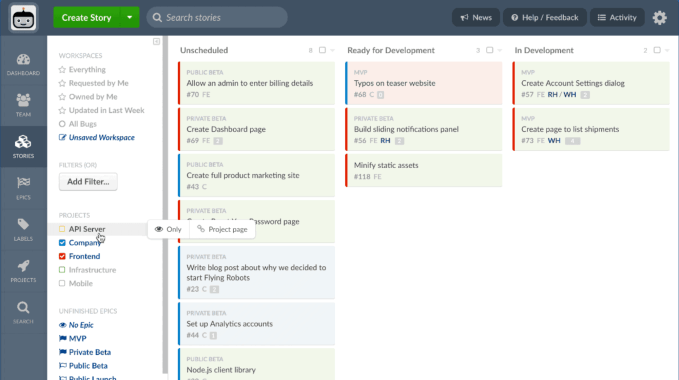People often describe work as a rat race, but for a lot of engineers, that isn’t too far off. Take one Jira ticket off the queue, fix the bug or add the feature, mark the ticket as complete and move as quickly as possible to the next ticket. Engineering for many organizations — perhaps despite the intentions of management — ends up being more like a deli counter or an I Love Lucy skit rather than a thoughtful prioritization of tasks for the end user.
Clubhouse is hoping to change all that. The product, which was launched in early 2016, is designed to remove the drudgery that developers feel when they use software project management software, all the while increasing every engineer’s visibility into their company’s top level goals and development milestones.
The company just got a boost to bring that hopeful vision to development teams across the world, securing a $10 million series A investment from Battery Ventures investor Neeraj Agrawal, who will also be joining the company’s board.
Clubhouse is all about providing efficiency for software developers. The software ties into Github to match commit records with tickets, so that developers don’t have to input the details of their changes into multiple databases. The product also offers an API that makes it easy to hook other tools into the development workflow.
While those features get rid of some of the drudgery of being a developer, it’s Clubhouse’s higher-level views that distinguish itself in the space. The product has “milestones” and “epics” built in, so that every person in the engineering organization can see the current status of critical features and releases. A status page allows developers to understand what their teammates are working on and what might be blocking them.

Clubhouse allows developers to organize their days and focus on workflows, not tickets
Kurt Schrader, the founder and CEO of the company, says that design was a critical element from day one. “We are very opinionated on trying to have the best and fastest and easiest to use UI/UX while still giving […] people a tool they enjoy using and that makes them happier,” Schrader explained to me. “Our opinion is that a workflow-based structure works better than an endless pile of tickets.”
Schrader started appreciating the problems in the software project management space while he was CTO of a New York-based company called Intent Media, a data science company for travel sites. There, in the hyper-competitive adtech space, he saw how quickly engineers could lose sight of what the goals of their products were amidst frenetic launch schedules.
Andrew Childs, a designer who had graduated from RISD, worked at Intent Media as the head of front end engineering. The two worked with each other, and when the time came to start a company, they joined forces to found Clubhouse.
For Schrader, product design was a key aspect of their early work before launch. “I think one big thing that we have tried to do from the very beginning is design the product so that every level of the organization can see what is happening. You can go from ‘what do I as a developer need to be working on?’ to ‘what are the 4-5 things we are building this quarter and how are we doing?’ We want everyone to be able to just do their work.”
What’s perhaps most incredible — and the reason Battery was so interested in investing — is that the company now has 700 companies using Clubhouse, yet the startup hasn’t hired a single salesperson. One pattern they have seen is that developers will often leave one company that was on Clubhouse, and then convince their new employer to begin using it as well. Schrader says that part of the Series A round capital will be used for building a more blended sales team.
Competition in the space is certainly a constant threat. In addition to Atlassian’s venerable Jira product, there are software packages like Pivotal Tracker, Fogbugz, and even GitHub’s own issues tracking system. Schrader acknowledges the competition, but argues that building the best designed tools will keep bringing in developers. “I think we actually charge more than Jira, so it isn’t the price point,” he said. “When we think about lowering the bar for engineering managers, how can we make the system update itself automatically so you can go about your day and just capture reality and not have a lot of overhead. We just put a lot of thought into keeping our customers happy.”
The company had previous raised $4 million across two seed round from Resolute Ventures, Lerer Hippeau Ventures, RRE, BoxGroup, among others. The existing seed investors joined Battery in the round.
